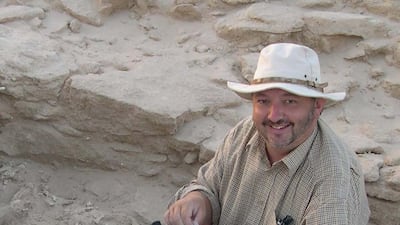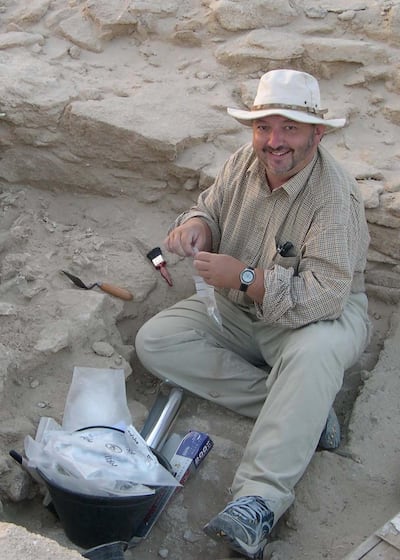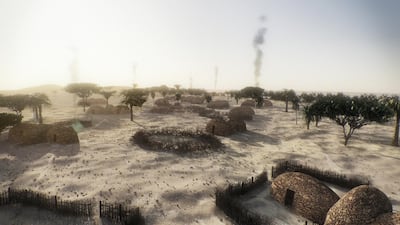Imagine a wetter, greener, cooler place - a country with more rainfall and even lakes.
This is what parts of modern-day UAE looked like about 8,000 years ago.
And the people? Forget simplistic Hollywood portrayals of primitive nomads struggling to eke out an existence.
They were sophisticated and skilled. They built permanent stone houses, knew how to navigate, herded sheep and goats, mined, made jewellery, fished, traded and even created decorative art.
This Stone Age community existed on Marawah Island. Marawah lies just off the coast of Mirfa town, about 160 kilometres west of Abu Dhabi city.
The Neolithic site was originally identified in the 1990s but only in the past few years has the extent and sophistication of the village settlement become more apparent.
More details about the archaeological finds centering around one site, MR11, will be discussed at NYUAD on Wednesday evening in a lecture by Dr Mark Beech.
Dr Beech is the leading archaeologist with the Department of Culture and Tourism – Abu Dhabi and he has directed the painstaking excavations on the island.
“People have a funny idea from Hollywood movies about the Stone Age and that the people are barbarians,” said Dr Beech.
“But they are clever and intelligent. They built their houses at the highest point to catch the breeze. They adapted, like we adapted with air-conditioning.”
The conditions for this type of life started with the end of the last ice age about 18,000 years ago. Global sea levels rose by about 120 metres. The Indian Ocean then slowly encroached on the Arabian Gulf which then starts to fill in and becomes a sea by about 6,000BC.
Excavations on Marawah Island using radio carbon dating methods have revealed how a settled community emerged during this time. The people constructed stone houses, the earliest examples of such architecture discovered in the Arabian Gulf, expertly exploited the sea and even took great care in their appearance.
They caught fish, dugongs, turtles and dolphins using lines made from gut and plant materials, deployed stone sinkers for larger nets and also made basket traps similar to modern-day metal cage gargours.
“If you stepped back in time and went to this village, you would see lots of things happening,” said Mr Beech.
“They are busy and occupied. They are not all struggling for food.”
Life expectancy for the people who lived on Marawah ranged from between 30 to 50 years. But because their diet was mainly fish, the people would have been reasonably healthy.
Studies on skeletons dating to the same period in other parts of the region also show their teeth were probably in a better condition than ours because of the little sugar they consumed.
Evidence unearthed also shows they started to use oysters for pearls as well as for food. “We have found mother of pearl buttons which are really delicate with holes drilled through them. They make all of these with flint stone tools,” said Dr Beech.
Another interesting find are plaster vessels which can be construed as the earliest expression of art found in modern-day Abu Dhabi. People on Marawah decorated gypsum stone with imported haematite iron ore from the nearby Dalma and Sir Bani Yas islands which have salt dome hills. These vessels imitated the more advanced Ubaid pottery from modern-day Iraq which also has been found on Marawah.
“They are astonishing,” said Dr Beech, of the plaster vessels. “These stripes imitate the decoration on Ubaid ceramics as Ubaid pottery was a cultural thing that everyone wanted, like an iPhone. But it’s not that simple – the people on Marawah are a local cultural group.”
The community on Marawah existed for more than a 1,000 years before a change in the climate meant that people moved on. Now it is a private, protected area – the Marawah Marine Biosphere Reserve and is an important habitat for dugongs and hawksbill sea turtles among others.
And Dr Beech, who has worked as an archaeologist in the UAE since the early 1990s, can still remember the first time he visited Marawah in 1994.

“I stepped on it and it was a magical place. Small traces of the old life still exist. So much of the coast now has been altered and modernised so it’s a beautiful place. A largely natural island with coastal mud flats and mangroves.”
Archaeologists will return to Marawah early next year for the new excavation season which last up to six weeks. Each season results in years of work for archaeologists who must identify, record and catalogue every find.
“It takes a long time to tell the full story. The next chapter will be unveiled at the lecture,” he said.
Life in Stone Age Abu Dhabi: Excavations on Marawah Island takes place at NYUAD on Wednesday at 6.30pm and is open to the public
_______________
Read more:
Earliest village discovered on Abu Dhabi island is evidence of an 8,000-year-old Gulf superhighway
Three new elephant trackways discovered in Abu Dhabi, archaeological conference reveals
Remains of Bronze Age Emirati settlement open to public for first time




